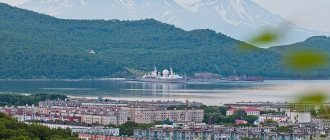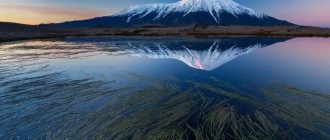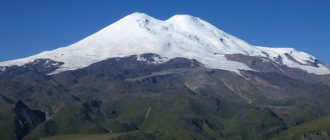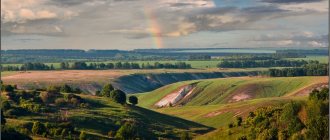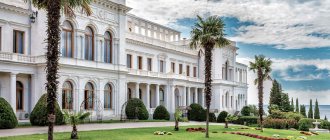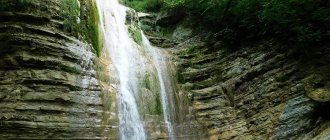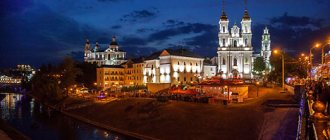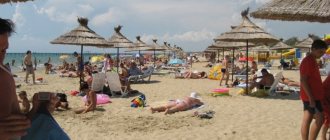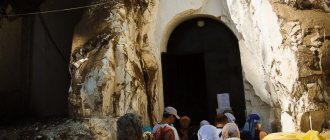Climb to the top of a lava mountain and look into the smoking mouth of a volcano, go in search of killer whales and whales, conquer inaccessible landscapes in jeeps and helicopters, and then swim in hot springs under the open sky. Listen to the hubbub of geese at bird markets, see with your own eyes the simple life of the Itelmens, Koryaks and Evens, taste the salt of the ocean and enjoy its gifts.
Kamchatka is a land that beckons with lush nature and promises bright adventures, where everyone in love with Russia dreams of visiting. Here, if you listen, you can hear the heart of the Earth beating. The project “Travel with the Russian Geographical Society” together with the tour operator RussiaDiscovery and the Vulcanarium museum offer to go to the ends of the world and explore the treasured Kamchatka from three angles - from land, water and air.
14_slashchilina_nina_-_s_dobrym_utrom_velikany_-_kamchatskii_krai_-_2020_-_524176.jpg
The calling card of Kamchatka is the recognition of its relief. Photo: Nina Slashilina, participant of the Russian Geographical Society photo competition “The Most Beautiful Country”
Kamchatka from the ground. Life among volcanoes
The transport system of the peninsula directly depends on the vagaries of the weather, which changes several times a day. The roads here are very limited, and often completely absent, so the most reliable companion for all tourists who venture outside the city limits is a Bigfoot jeep. There are many routes of varying degrees of difficulty for off-road vehicles across the peninsula. You can get to most of the volcanoes - there are more than a thousand of them, about 30 of which are permanently active. No less tempting are the constant companions of the fire-breathing mountains - thermal hot springs; the natural pools of many of them emerge right in the middle of fumarole fields - gas craters on the slopes of volcanoes.
All the lava giants were included in the UNESCO World Heritage List back in 1996 and are divided into five protected natural areas, each of which has its own list of must-see attractions.
Tourism
Kamchatka Territory is a unique mountainous region of Russia. Here you can see ecologically clean wildlife with fauna and flora untouched by human activity. The attention of travelers will be attracted by the unique phenomena of the peninsula, natural monuments and the original culture of its few nationalities.
Tourist routes in Kamchatka, as a rule, pass through areas isolated from civilization, where wild mountain nature is located. There is a high probability that the weather will suddenly worsen, hurricane winds will blow and heavy rain will fall.
ekaterina_vasyagina_vremya_sozercat-525059_kronockii.jpg
Bears are the masters of the Kronotsky Nature Reserve.
Photo: Ekaterina Vasyagina, participant in the photo competition of the Russian Geographical Society “The Most Beautiful Country” Kronotsky Nature Reserve is one of the oldest biosphere reserves in Russia. Kronotskaya Sopka is an active stratovolcano and Kronotskoye Lake, the largest freshwater lake in Kamchatka. There are also unique natural objects here - the caldera (basin) of the Uzon volcano, which is a system of thousands of thermal and mud springs, and the famous Valley of Geysers.
Klyuchevskoy Park is the youngest reserve, the keeper of the highest volcano in Eurasia - Klyuchevskoy Sopka, as well as famous giants - the Kamen, Bezymyanny, Ostry and Plosky Tolbachik volcanoes. In addition, here you can find about five dozen glaciers and several hundred lava flows.
Bystrinsky Park is known for its healing thermal springs, which also heat the homes of local residents. The Beringia national sled dog racing festival takes place here, as well as several ethnographic Koryak and Even camps.
Cities of Kamchatka
The cities on the peninsula are small both in number and in area, since the territory is sparsely populated. This place seems to many to be the “edge of the world”, because the distance from Moscow to Kamchatka is 6773 km.
There are three cities in the region:
- Petropalovsk-Kamchatsky
- Elizovo
- Vilyuchinsk
In which about 242 thousand people live. The remaining 74 thousand inhabitants of the peninsula are concentrated in villages and hamlets; most local residents are engaged in fishing, because caviar and fish from Kamchatka are sent to all regions of Russia. Many settlements are located next to nature reserves, national parks and wildlife sanctuaries, where scientists study the amazing plants and animals of Kamchatka. Some residents of cities and villages are engaged in folk crafts and collecting medicinal herbs, since herbal teas, products made of leather, fur, bone, wood and birch bark are considered valuable gifts from Kamchatka. By the way, prices in Kamchatka, due to the remoteness of the region, are very high, even for fish and seafood.
Petropavlovsk-Kamchatsky is the largest city on the Kamchatka Peninsula
korostelev_mihail_-_lyubopytstvo_-_2018_-_382140.jpg
Bear hunting.
Photo: Mikhail Korostelev, participant in the photo competition of the Russian Geographical Society “The Most Beautiful Country” Nalychevo Park is, first of all, the “Central” cordon, a favorite place among rare tourists in the valley of the Bear Tundra with hot springs equipped for swimming. The Nalychevo thermal system is the oldest and has no analogues in the world: the water of these sources is heated by slowly cooling lava, which gives off its heat and warms up the thermal baths to 75 degrees. In addition, there are volcanoes of the Avachinskaya and Zhupanovskaya groups.
The South Kamchatka Nature Reserve is the maximum concentration of active volcanoes in Kamchatka, which are constantly changing the landscape of this area - Vilyuchinsky, Mutnovsky, Gorely, Zheltovsky, Ilyinsky. There is also the Ksudach caldera volcano, which has several crater lakes filled with thermal water. On the shore of one of them there is the so-called Hot Beach, where you can sunbathe even in winter.
In the author's Volcano Travel expeditions with volcanologist guides, the routes pass through the Avachinskaya and Gorelo-Mutnovskaya groups of volcanoes, the caldera of the Uzon volcano and the Valley of Geysers, and also involve climbing one of the largest volcanoes of the peninsula - Ichinsky.
Life among volcanoes - the active masters of these lands - left its mark on the life and customs of numerous ethnic groups living on the territory of Kamchatka. Koryaks, Itelmens, Aleuts, Evens - simple hunters and reindeer herders - identified the breath of the fiery mountains with the expression of the will of the gods. This is also why it was not customary for them to help those lagging behind or save drowning people, so as not to interfere with the spirits taking their victims. Nowadays, an atmosphere of nomadic life can be found in some surviving ethnic camps.
Flora
Where the Kamchatka Peninsula is located, strong winds blow and there is a short summer. These factors, as well as the isolation of the territory from the mainland and loose volcanic soils, gave a special character to the vegetation of the harsh region. The species composition of the flora is not particularly rich. There are just over a thousand fern and flowering plants here. Among them there are species that are not found anywhere else.
Forests on the peninsula occupy one third of its area. White and stone birch, alder and spruce, Kuril larch and willow, rowan and poplar, hawthorn and bird cherry grow here. Berry bushes are represented by honeysuckle and lingonberry, blueberry and crowberry. Cranberries are found in swampy areas.
In high mountain areas, dwarf species of alder, birch and willow grow. Shelomaynik is widespread. On the high mountain plateaus you can find only unpretentious tundra vegetation.
strashno_no_prekrasno-401599.jpg
Photo: Sergey Nalivaiko, participant in the photo competition of the Russian Geographical Society “The Most Beautiful Country”
In the Koryak settlements of Eyvet, Tanynaut, Kainyran and Chau-Chiv, they will talk about the features of the fur trade, teach how to perform national dances to the accompaniment of jew's harps with tambourines and how to build yarangas - aboriginal huts. In winter, you can go dog sledding here, and in summer, you can taste healing teas made from fresh aromatic herbs against the backdrop of lakes and volcanoes.
To preserve and popularize the heritage of the Itelmen, was created . Here you can see booths - summer and winter camps on stilts, attend workshops on sewing clothes and jewelry, get acquainted with the national cuisine, and to enhance the experience - take part in shamanic rituals and walk on coals.
Accommodation
The tourism sector in the Kamchatka Territory is developing at a rapid pace. Every year more and more tourists visit it. Despite this, there is still little competition here, and this is reflected in the cost of local housing. There are still few truly good hotels even in Petropavlovsk. As a rule, these are private guest houses, villas and mini-hotels that delight you with warm service, good breakfasts and hospitality. This is evidenced by numerous photos posted on the Internet by tourists who have recently returned from a trip to Kamchatka.
Another option is to use Airbnb and similar booking services. Do you want to visit Kamchatka and save as much as possible? Take a closer look at local hostels or good recreation centers. This is especially true in the low season, when there are much fewer tourists. You can always write to the host and ask to send a photo of the accommodation you plan to stay in during your visit.
olga_logvinec_goryachaya_zemlya_kamchatka-491922.jpg
The Valley of Geysers is the hot land of Kamchatka.
Photo: Olga Logvinets, participant in the photo competition of the Russian Geographical Society “The Most Beautiful Country” A peculiarity of the Evens, who came to Kamchatka from Yakutia three centuries ago following the Russian discoverers, was the tradition of riding reindeer not in a sled, as other northern peoples did, but on horseback. A reconstruction of the Even camp can be seen in the ethno in Bystrinsky Park. In the summer, you can watch and take part in reindeer racing, learn how to throw a lasso and tan a skin, and you can stay overnight in one of the yaranas.
The Aleuts are one of the vanishing indigenous peoples of Russia: the majority of representatives of this ethnic group live in Alaska; according to the 2010 census, just under 500 people remain in our country. You can get acquainted with their cultural heritage in the village of Nikolskoye on Bering Island - the only settlement in the Aleutian region. In the middle of the last century, the Local History Museum was opened here, the exhibition of which tells about Kamchatka expeditions, sailors and the settlement of Kamchatka residents. The ethnographic exhibition is dedicated to traditional authentic household items of the Aleuts and traces of ancient sites of the Neolithic era.
Interesting places to relax with children
The sights of Kamchatka are interesting to people of all ages. When traveling with a child to these places, adults are concerned about organizing leisure time not only for themselves, but also for their children.
Vulcanarium in Petropavlovsk-Kamchatsky
Address of the museum, which will be interesting to visit for both children and adults: st. Klyuchevskaya, 34. Unlike the scientific museum of volcanology, the exhibition of which is aimed at trained specialists, this small private museum will tell about volcanic activity in an accessible and non-boring form.
The interactive components of the excursion will help to visualize the processes occurring deep underground and leading to a volcanic eruption. An adult ticket costs 800 rubles, a child ticket costs 500.
Puppet Theatre
The theater has been operating since 1980, annually creating new productions for children and adults. The theater troupe of 28 people also works with long-lived performances that have been known to more than one generation of Kamchadals. The fairy tale “Buka” has been on stage for more than 30 years; both “The Scarlet Flower” and “Shreds in the Back Streets” are in demand.
The selection of performances for older audiences and parents is mandatory and is distinguished by taste and professional performance. In theater productions, there is a dialogue form of communication with the audience, which is always well received by children.
Sled dog kennel "Eivet"
The Koryak camp is located in the village of Nikolaevka. Guests are hosted by the A. Pritchin family, who will introduce guests to the culture, traditions, songs and dances of the indigenous peoples of Kamchatka. The kennel's dogs are famous participants in the Berengia races. After undergoing a short training at the “musher school”, tourists will be able to drive the team independently.
The program is designed for 2-2.5 hours of exposure to the air, and will cost 2.7 thousand rubles. for an adult and 1.8 thousand rubles. child under 12 years old.
smityuk_yurii_-_kosatki_-_kamchatskii_krai_-_2020_-_509516.jpg
If bears rule the land, then killer whales are the rulers of the seas. Photo: Yuri Smityuk, participant of the Russian Geographical Society photo competition “The Most Beautiful Country”
Kamchatka from the sea. Whales and seals
The coast of the peninsula, washed by the Bering and Okhotsk seas, as well as the Pacific Ocean, is indented by a large number of picturesque bays, the rocks of which are a favorite place for bird colonies and sea lion rookeries. It’s nice to combine a vacation on a yacht with fishing or diving, but the most exciting adventure in coastal waters will be a photo hunt for killer whales and whales. You can observe the inhabitants of the oceans as part of scientific cruises, accompanied by biologists who will tell you about all the habits of sea animals.
A scientific adventure cruise along the south-eastern coast of Kamchatka on a sailing catamaran from RussiaDiscovery passes through the Avachinskaya, Bechevinskaya, Morzhovaya, Zheleznaya and Russkaya bays, introducing you to the fauna of the Pacific Ocean and the research activities of scientists. In addition to watching animals, you can go kayaking, paddling, and fishing.
On the edge of the world
The Kamchatka Peninsula is located in the northeast of the Eurasian continent. It is connected to the mainland by a narrow isthmus called Parapolsky Dol. From the west it is washed by the waters of the Sea of Okhotsk. The Pacific Ocean splashes from the east. The length of the peninsula exceeds 1200 kilometers. By Russian standards this is not a very long distance, but by European standards it is very impressive. For example, Germany is a fairly large country, but its length along the long side is less than Kamchatka!
Pacific Ocean
In 1651, one of the first Russians to visit Kamchatka was the explorer Mikhail Stadukhin, who was looking for access to the Penzhina River. This happened after a two-month rafting trip down the Anadyr River. A little later, Cossack Leonty Fedotov and businessman Sava Anisimov Seroglaz visited these places. At the beginning of the 18th century, the navigator Vitus Bering circumnavigated Kamchatka on a ship. The history of the region at the beginning of the 20th century is well represented in the film “Wealth,” based on the novel of the same name by Valentin Pikul.
Now these lands are officially called the Kamchatka Territory. You can’t find a person in Russia who hasn’t heard anything about him. It is surprising that with such fame, no one knows exactly how the name Kamchatka appeared. Today there are more than 20 versions of its origin! There are probably no analogues to this toponymic riddle.
Some believe that the peninsula was named after the Russian pioneer Ivan Kamchaty. Others claim that the name came from the Kamchatka River (then why was the river called that?). There is a version that the name is derived from the Yakut word “khamchakky” - “smoking pipe”. Numerous Kamchatka volcanoes could indeed give rise to such an analogy.
The peculiarities of Kamchatka weather are largely determined by the geographical location and terrain. In the central part of the peninsula, fenced off by high mountains, it is much warmer than on both coasts, blown by the winds. In the east, the weather can change rapidly. The heat suddenly gives way to cold rain. But after a couple of hours, “late autumn” again turns into sunny “summer”.
Winter in Kamchatka
While winter on the coast is mild, away from the ocean it is colder and windier. In the north of the peninsula, snow appears in September, and in the south only at the end of October. During the summer months, the east coast is hot, but the center is cool. The highest temperature recorded in Kamchatka is + 34 degrees, and the lowest is minus 26 degrees. Throughout the year, the peninsula is dominated by winds that cause storms. Most often they rage in the south.
There are many rivers and streams on the peninsula
Kamchatka has a fairly dense river network, which is fed by glaciers in the mountains. Therefore, the water in them is clean. The largest river is called Kamchatka. In addition to it, there are another dozen and a half rivers. Rafting enthusiasts have long mastered the Avacha and Malkinskaya Bystraya rivers. There are also 14 lakes on the peninsula. Kronotskoye Lake is considered the largest. Some of the reservoirs are located in the craters of extinct volcanoes.
olga_logvinec_zolotistye_kotiki-539251.jpg
Fur seals get their name from the gorgeous whiskers that this type of seal has, and they are also distinguished by the presence of an auricle.
Photo: Olga Logvinets, participant of the Russian Geographical Society photo competition “The Most Beautiful Country” By sea, in search of whales, you can get to the nearby Commander Islands - the tops of underwater volcanoes, the home of fur seals and red-billed puffins. The islands' intricate topography is one of the best places in the world for birdwatching, with about a million different birds nesting on the cliffs here. In the waters of the Commanders you can find about 20 species of whales: gray, humpback, Japanese, sperm whales. You can watch giant mammals here all year round.
Wonders of nature
The grove is a scientific phenomenon that no one today can explain. The forest area is surrounded by volcanoes, half of which are considered active. The deepest lake on the peninsula is also located here. It is freshwater, its depth reaches 150 m. Rare species of animals live in the reserve. We are talking about the Pacific porpoise, sable, brown bear, and black-capped marmot. There is a rookery for sea lions in the reserve. Up to five hundred individuals visit it annually.
Next to the Kronotsky Nature Reserve is the Komandorsky Nature Reserve. the date of its formation is 1993. The area of the territory exceeds 3,600 hectares. It occupies the Commander Islands, which are home to twenty-five species of mammals.
andrei_belavin_syorfing_na_kamchatke-552254.jpg
Surfing in Kamchatka is a test of yourself.
Photo: Andrey Belavin, participant of the Russian Geographical Society photo competition “The Most Beautiful Country” Water sports enthusiasts will find many activities in Kamchatka. The most unobvious way to catch adrenaline is surfing. They started catching waves on local beaches about 10 years ago, but during this time the 15-meter waves of the Pacific Ocean managed to win their regular audience. The main surf spots can be found on Khalaktyrsky beach, covered with volcanic sand, located half an hour from Petropavlovsk-Kamchatsky. The water temperature, even in summer, rarely exceeds 15 degrees: the cold waters of the ocean attract those who like to test themselves. There are no populated areas nearby, but several surf camps are set up here during the season.
Flights and transport
Depending on the time of year and season, the difference in the cost of air tickets to Petropavlovsk-Kamchatsk can be very significant.
However, “portions” of cheap air tickets from Aeroflot and other carriers go on sale every year in the fall or winter. In order to find good prices, you should subscribe to the Big Country newsletter, indicating the tour dates you are interested in. Plan your trip in advance.
Cheap air tickets to visit Kamchatka in the summer season can usually be purchased in the fall of the previous year. If you want to save on air travel, the best solution would be economy class from Moscow. At the same time, the number of inexpensive tickets is limited, and it is quite difficult to catch them.
You can book a more or less inexpensive flight to Kamchatka in October, December, throughout the spring, and sometimes even during the high tourism season. Buying tickets at least six months before your planned trip during sales periods will help you save a lot. In many cases, these savings can amount to up to a third of the average annual cost.
A good option is to entrust the search for cheap tickets to a tour operator. While you only use a few sites for these purposes, companies that are professionally involved in tourism have much wider opportunities.
andrei_belavin_zemlya_vulkanov-551815_s_vertoleta.jpg
Weather conditions often play into the hands of the cosmic landscapes of Kamchatka. Photo: Andrey Belavin, participant of the Russian Geographical Society photo competition “The Most Beautiful Country”
Kamchatka from the air. Alien landscapes
A helicopter in Kamchatka is the second most popular method of transportation after an SUV: everything that cannot be reached by land can be seen from the air. The most popular rotorcraft on the peninsula is the Mi-8, with a capacity of up to 20 people - a kind of flying bus, ready to take you to any height. Some protected areas, such as the Valley of Geysers, can be reached entirely by air; driving around the Kronotsky Nature Reserve is also prohibited.
From above, the landscape of the peninsula looks different: volcanic craters and fumarole fields form unearthly landscapes. Bizarrely smoking geysers, calderas of all colors, cones of young volcanoes growing from the womb of older ones, the destroyed craters of which are filled with blue-green water. You can explore the main attractions of Kamchatka from a helicopter in a week, while moving around on your own can take several months.
Geography
The peninsula is connected to the Russian mainland by an isthmus, the width of which does not exceed 100 km. The largest bays in the region are Avachinskaya, Ossora and Karaga. In some places, rock formations jut out into the sea, which almost completely disappear on the west coast. Kamchatka is located between Chukotka and the Kuril Islands. The unique location and relatively large extent of the peninsula lead to a variety of climatic and natural conditions.
In the place where Kamchatka is located, the average annual air temperature is approximately 5 °C lower than in neighboring regions. The weather in these parts is influenced by icy sea currents. Their impact is most pronounced in the summer. Powerful anticyclones bring prolonged downpours to the peninsula, which provoke the formation of mudflows. Floods occur in late spring.
matveev_aleksei_-_manyashchii_bereg_-_2020_-_480605_vertolet.jpg
From the height of birds' flight, the real beauty of the Kamchatka mountains and lakes is revealed. Photo: Alexey Matveev, participant of the Russian Geographical Society photo competition “The Most Beautiful Country”
You can fly through the “home” volcanoes and the Zhupanovskaya group ridge to the Karymsky and Maly Semyachinsky volcanoes and study various manifestations of modern volcanism as part of a Volcano Travel tour, where you will be accompanied by volcanologists.
In addition to the lava giants, the owners of the Kamchatka land are bears. It is also convenient to observe them from a helicopter; their largest population - about 250 individuals - is concentrated in the area of the crater Kuril Lake, formed as a result of a tectonic depression more than eight thousand years ago. Also from a helicopter you can see the Heart of Alaid, a pink volcanic island located in the center of the lake, which is associated with many legends. The Alaid volcano itself is located in the Sea of Okhotsk, where, according to legend, it was forced to retire so as not to block the sunlight with its height, but its heart remained in Kamchatka.
Julia Gopius
Natural phenomena
Kamchatka is a peninsula on which a special combination of climatic and physical-geographical conditions contributes to the emergence of dangerous hydrological processes. These include mudflows and snow avalanches, catastrophic and sharp rises in river levels after large amounts of rain, as well as channel deformations, ice jams, etc.
Kamchatka is a peninsula that is part of the so-called fire belt, which includes volcanic ridges. Mountain-building and other geological processes often occur here. They result in earthquakes and volcanic eruptions.
Attractions
There are dozens of beautiful, interesting places in the region. It will take a year to see everything.
But there are places that are especially popular with tourists:
- Avachinsky volcano;
- Avachinskaya Bay and the Three Brothers rocks;
- Valley of Geysers;
- Volcanic calderas in the Kronotsky Nature Reserve;
- Commander Islands;
- Tolbachik Volcano and Dead Forest;
- Kuril Lake;
- Blue Lakes;
- Acid lakes (Gorely and Maly Semyachik volcanoes);
- Klyuchevskaya Sopka;
- Salmon Museum;
- Kukhtiny Bati;
- Balneological resort (Paratunka village);
- Cruise on the expedition ship "Akademik Shokalsky".
The first visit by Russians to the land of Kamchatka
In 1648, Fedot Alekseev Popov, together with Semyon Dezhnev Sea, went to the mouth of Anadyr on Kochs in search of new fishing areas. The ships were caught in a storm and Popov was separated from his companions. When his koch was washed to the ground, he turned out to be the first Russian explorer in Kamchatka. This became known 80 years later, when the Bering expedition rediscovered the passage between Asia and America.
In 1697, the Yakut Cossack Vladimir Vasilyevich Atlasov, together with Luka Morozko, undertook a study of the geography, climate, flora and fauna of the new land.
In 1700, he, already in Yakutsk, wrote down the information collected in detailed “skasks” (stories); At the same time he drew the first map of Kamchatka. A year later, having arrived in the capital, Atlasov presented a report on his campaign to the king. So Kamchatka was annexed to the Russian Empire.
